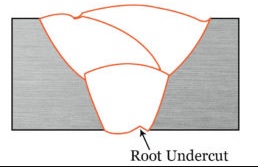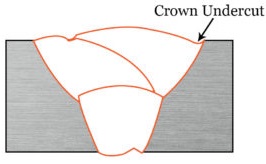Undercuts in welding are among the most common welding defects every welder encounters at some point in their careers. Although the welded area becomes weak and prone to cracking, undercuts can be greatly minimized with proper welding techniques.
To prevent undercut in welding, it is important to learn why undercut occurs so that effective preventative methods may be implemented.
What is Undercut in Welding?
Undercuts are grooves along the underlying metal surface in a welded joint. They appear more frequently in fillet and butt joints.
Undercuts are mainly considered dangerous due to their tendency to reduce the thickness of parent metal. As a result of this reduction in thickness, quality, and strength of the weld and structure are reduced.
When it comes to undercuts, it’s important to know that they can come in two different types: Internal or Root Undercuts and External or Crown Undercuts.
Internal Undercut or Root Undercut

Internal Undercuts or Root Undercuts usually appear as depressions or lines near the parent metal weld connection. In Radiographic Testing, both Undercuts and Root Undercuts will show up as dark lines next to the welded area.
External Undercut or Crown Undercut

A crown undercut or external undercut occurs near the weld area’s toe or crown on the parent metal.
In a radiograph, the crown undercut can show up as a dark line around the welded area’s edge.
Causes Of Undercut In Welding
The reason for an undercut is quite straightforward, so it’s time to start learning what causes one.
1. The Current Is Too High
With high currents, high temperatures are generated, which causes the parent metal to melt along its edges. The melted metal that results from this excessive heat drains into the welded area, increasing the chance that an undercut may form.
2. Excessive Amounts Of Voltage
High voltages can make the electrode reflow rapidly from side to side, resulting in low fusion levels between the metal and filler material. The molten electrode can mix with the metal, quickly causing undercuts to develop.
3. Poor Weaving Skills
Insufficient weaving skills can increase the welding speed; therefore, causing undercuts. For example, weaving too fast causes uneven distribution of heat, resulting in inconsistent melting of metal, leading to undercuts.
4. Use Of The Incorrect Filler Material
The irregular cohort of molten metal leads to an undercut formation when temperature differences are created due to the faulty filler materials.
5. Insufficient Supply Of Filler Material
There will be adequate filler material deposited in a good weld only as long as there are not too many filler materials deposited at the weld area.
6. An Improper Angle When Placing The Electrode
By holding the rods at a wrong angle, uneven heat is distributed to the edges, increasing the probability of undercuts forming. When the electrode is incorrectly positioned, too much or too little molten metal is generated in the welded area leading to undercuts.
7. Welding Surfaces That Have Debris
Paint, dust, rust, moisture, and other deposits made on welding surfaces are more prone to producing undercuts. These foreign particles interfere with the metallic properties, making the fusion of the molten metal difficult.
8. Poor Selection Of Shielding Gas
Shielding gas that’s contaminated or mixed incorrectly can interfere with the metal’s properties, leading to undercutting.
9. Having An Improper Welding Position
Undercuts result from welding on unstable benches, and the electrode may be raised at an angle that interferes with the quality of the connection. Therefore, the filler material is not distributed evenly across the metal during the welding process resulting in undercuts.
Read our guide about : Welding Positions : 4 Main Types of Welding Positions
10. Incorrect Electrode Size
Using large electrodes can lead to undercuts, as electrolysis removes too much metal. Welding rods of the correct size should also carry high currents without interfering with the supply of molten metal or deforming the metal. Extremely small electrodes will not generate enough molten metal, resulting in welding defects.
11. Excessive Arc Length
Welding arcs are the zones between the tip of the welding rod and the material to be welded. When the arc is larger than the electrode diameter, the metal covers a greater area than intended, which leads to decreased undercuts.
How To Prevent Undercut In Welding
Knowing what causes undercuts, as with any welding defect, is the first and most important step in preventing this defect. Just finding out how they occur can eliminate any welding defect.
Furthermore, you should also be aware of preventive methods you can apply to greatly reduce undercuts in your welds to knowing the basics. The following are the most effective preventive methods you should apply.
1. Using The Multi-Pass Welding Process
The fusion properties of the metal become stabilized with this process, reducing the rate of undercuts. Here is an excellent guide you can use if you are interested in finding out more about the multi-pass welding process.
2. Regulate The Length Of The Arc
Spattering and undercutting can result from welding at a distance from the molten metal that is greater than a rod diameter. For example, when welding an eight-inch diameter, the electrode should be no more than an eighth of an inch away from the base.
3. Proper Weaving Technique
Another method of preventing undercutting is to master the weaving technique. Regular pauses on each side of the weld lessen the amount of molten metal splashing. Undercuts also occur when the electrode weaves at high speeds.
4. Appropriate Use Of Shielding Gas
Suppose air gets in contact with the molten metal. In that case, the subsequent reaction could lead to metal undercuts, so it is imperative to protect the metal from oxygen and other atmospheric gases. The combination of gases in the shield should correspond to the metal type and thickness.
Inexperienced welders have a tough time choosing the correct shielding gas. If you fall into that category, you can watch a video below to guide you in choosing the right gas.
5. Correct Position And Angle
In addition to the risks mentioned above, the angle you maintain while welding is extremely important. Here are some tips to keep between the correct angles:
6. Optimize Travel Speeds
- Wire Welding – The gun should be angled 10-15 degrees in the direction of the weld while you push it into place.
- Stick Welding – It is important to maintain a 30-degree angle on dragging as you do.
6. Optimize Travel Speeds
While welding, some welding processes can fail due to low travel speed. Low travel speed can lead to undercuts, burn through, incomplete penetration, interspatter, cracking, and other defects. Travel speeds must be such that the weld metal can fully fill the joint area.
7. Prepare Metal Surfaces
The metal surface needs to be welded to be cleaned before welding to prevent flaws like undercuts. Surfaces that contain deposits like rust, paint, moisture, and oil interfere with the welding process.
Stop as soon as you reach the debris to allow trapped bubbles to blow out before the metal solidifies and the metal becomes solid.
8. Stable Work Environment
Welders should use sturdy clamps to fasten structures being welded, putting as few undercuts as possible. A solid working bench is essential to get the path of motion right during welding.
FAQs
What is the main cause of undercut in welding?
There are many reasons why an undercut can occur: Excessive heat generated by high current and voltage settings can cause an undercut. The electrode can move away from the welding pool prematurely if the travel speed is too fast. The presence of dirt or grit on the welding surfaces can block the transfer of heat, resulting in undercutting if the edges are not properly prepared.
How do you correct undercut in welding?
It is quite common to use stringers or weave beads to fill up undercuts since they are often narrow and long. It is also possible to grind the flaw off with an angle grinder thoroughly since undercuts tend to be narrow and long. There is only one way to use this method if the joint has enough thickness to withstand the reduction in strength.
How To Repair Undercut In Welding ?
In the welding industry, whether or not to repair an undercut can be a difficult one. Costs should be weighed against benefits before arriving at a decision. No matter which option is chosen, repairing an undercut is possible and can be easy, depending on the severity.
Two of the most common ways to fill the undercut groove are to use the weaving technique or stringer beads technique. There is also the option of grinding down the weld, but this can reduce the overall strength.
According to AWS regulations in regards to repairing undercuts, they state:
It shall not be mechanically nicked or gouged adjacently to the weld metal. Removal of metal may also be accomplished through grinding, chipping, or gouging.
As-rolled steel shall be permitted for use. Any unwanted portions of the weld must be removed without substantially removing the base metal. The surfaces must be thoroughly cleaned before welding. Weld metal must be deposited to make up for any deficiency in size.
There is an acceptable amount of undercut allowed in a weld regardless of why the undercut cannot be fixed.
When is an acceptable amount of undercut allowed?
To comply with the recommended thickness of a section, the undercut must not go over 0.5 mm, and it should not interfere with the minimum requirement for section thickness. Undercutting’s deeper than 1/32 inch are unacceptable.